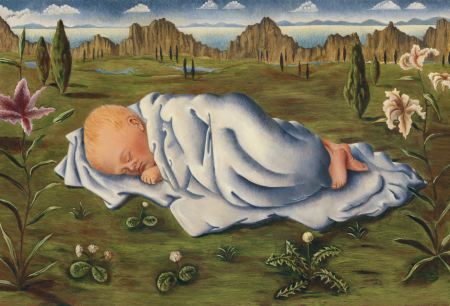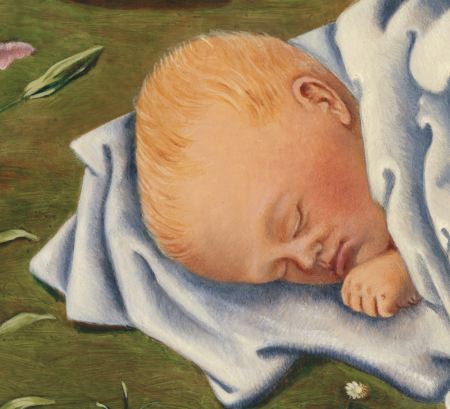Posted by Steve Durbin on January 29th, 2007

I’d like to describe a collaborative experiment that started from recent attempts to use simple image manipulation to aid in discussing visual art, such as painting (see comment 6 here) or fiber art (comment 12 here). Quite a few artists these days work partly or wholly digitally, and I wondered whether some of the advantages (like Undo!) could be carried over to an otherwise non-digital workflow.
In one of the posts mentioned above, June Underwood described her huge, inspirational, and ongoing project at John Day Fossil Beds National Monument. I proposed to cast myself as her assistant:
more… »
Posted by Hanneke van Oosterhout on January 27th, 2007

This painting of Françesca I made when pregnant with Nino (Fran was one year old then). We were living in Germany and I painted only an hour or two each day because I was too tired to sit longer (I was really big at that point).
It is based on drawings of Françesca sleeping, combined with my imagination. I find it wonderful to paint people.
Before I committed myself to still life painting I was working together with Karl using his rediscovered techniques of the old masters.
That is how I learned to use the different layers of paint in a simple and logical way.
I used to paint from my imagination, now I seem to have left that behind. How do you balance between reality and fantasy in your work?

. . .
more… »
Posted by Karl Zipser on January 4th, 2007
Is children’s art “art”? Steve said that age does not matter; Derek, June, Bob and Arthur were ambivalent. I thought I should ask a Françesca (four and a half years old) for her opinion about what she makes, and also about work by “grownups.”
more… »
Posted by Bob Martin on January 4th, 2007
For some of us, resolving a painting is more difficult then it should be. Once started, I am not able to see what I am doing with a clean mind. There are elements that I fall in love with a try to work around them, but never seem to get the entire painting to work. Recently I discovered that a painting that was testing my identity as an artist (another way saying, gave me great doubts about my ability) only needed for my scrape out the one thing that I thought was working for me, in order for the the rest of the painting to come alive.
Occasionally or almost always, the paintings become overworked. Knowing when to stop is a good thing. I have tried all of the little tricks you can use to play with your mind, like hiding the painting in a closet for a week, the black mirror, turning it upside down etc. Anybody have any other ideas?
Posted by Karl Zipser on December 30th, 2006

Painting From Life vs. From Photos
Hanneke can’t post today and she asked me to fill in for her. I wanted to remark on an interesting trend in some of the comments about her work. For example, looking at an image of Old grapes, new painting, Colin Jago wrote “I seem to be looking down on the grapes and up at the glass.”
For Colorful Underpainting, Steve wrote “my first impression was that the cloth was somehow mounted on a wall. The bunch of grapes and the way they rest on it make this interpretation virtually impossible, of course, but I still don’t feel the correct perspective as strongly as I would like to.”
Hanneke paints her still life paintings “from life” and she tries to paint what she sees. Is she trying to show multiple viewpoints, or to produce distortion in perspective? Not intentionally, she has said. But is she doing so unintentionally?
Let’s take a look at Hanneke’s imaginary still life drawing and see if can find out more about the viewpoint issue.

In this imaginary still-life, the vessel is seen directly from the side, but the table top and fruit are seen from a different perspective, from above. We seem to look down on the table top while looking at the vessel from the side. This merging of different perspective points lends an interesting quality to the imaginary drawings. More examples of her “multiple viewpoint” imaginary drawings are here, here and here.
Let’s compare this to a drawing made directly from a real still life the same week when she made the imaginary drawings:

Do you see the difference? In this drawing from a real still-life, multiple viewpoints are not manifest. The fruit and the vessel are both seen from the same viewpoint.
I think that Colin and Steve are on to something with their comments about Hanneke’s painted still life work. In the “from life” still life paintings, the perspective may be technically correct, but she sometimes manages to produce a feeling of different viewpoints nonetheless. Would it be interesting if she tried to bring this difference in viewpoints more explicitly into her “from life” still life paintings? Or, should she work to correct the apparent flaw when it occurs?
Posted by Rex Crockett on December 29th, 2006
I’m not sure that this post will be very interesting or useful to anyone here since it seems that what I do, artwise, is not something anyone else does. I have not even heard any aspirations in the direction of classical figure drawing either, but here, nevertheless, is a quick synopsis of my method.
I decided to attempt to recover some of my earlier methods in order to illustrate the story, but lacking pastels for the moment and furthermore basically despising using the computer to simulate the effects, I recovered only certain aspects of the earlier style — mainly a sense of dynamic motion and form. If you’d like to see some more, you can have a look at the non romantic exposé of my penultimate post. I lacked the time before, but this past week and a half, I’ve done nothing but make time and pick up the pace, so here’s my first recent blush at a classical theme in a long time — the fight between Heraklos and Antaeus.
more… »
Posted by Karl Zipser on December 25th, 2006
Françesca’s fifth birthday is coming up in March.
Karl: Who do you want to see your drawings?
Fran: All the people from the whole world, and also grandma and grandpa.
more… »





